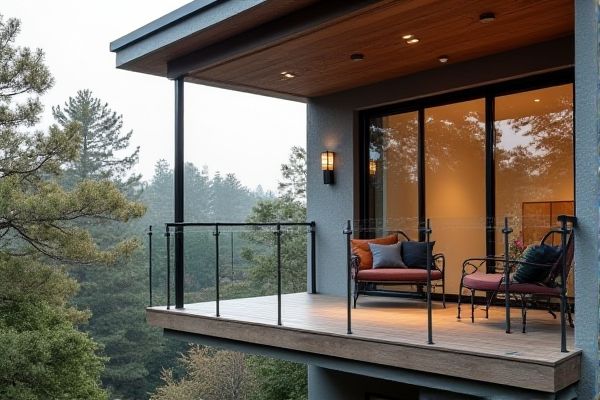
Glass railing offers a sleek, modern look with unobstructed views and low maintenance, while cable railing provides a durable, minimalist design that allows air flow and requires occasional tension adjustments. Explore the rest of the article to determine which railing best complements your porch style and functionality needs.
Table of Comparison
| Feature | Glass Railing | Cable Railing |
|---|---|---|
| Appearance | Transparent, modern, sleek | Open, minimalistic, industrial |
| Visibility | Unobstructed view, clear sightlines | Good visibility but with horizontal lines |
| Maintenance | Regular cleaning to remove smudges and dirt | Occasional tension adjustment and cleaning |
| Durability | Tempered safety glass, weather-resistant | Stainless steel cables, corrosion-resistant |
| Safety | Solid panels for higher safety, child-friendly | Strong cables but gaps may pose risk to small children |
| Installation | Heavier, requires professional installation | Easier to install, flexible design options |
| Cost | Higher upfront cost due to materials | Generally more affordable |
| Wind Resistance | Provides wind barrier, reduces breeze | Allows wind flow, less wind resistance |
Glass Railing vs Cable Railing: An Overview
Glass railing offers a sleek, modern appearance with unobstructed views and superior wind protection, making it ideal for porches facing scenic landscapes. Cable railing provides a minimalist look with durable stainless steel cables, ensuring low maintenance and excellent ventilation without blocking sightlines. Both options enhance porch safety and aesthetics, but glass is preferred for clear visibility while cable railing suits contemporary, airy designs.
Aesthetic Appeal: Modern Styles for Your Porch
Glass railing offers a sleek, transparent look that enhances natural light and creates an open, contemporary feel for your porch. Cable railing provides a minimalist and industrial aesthetic with thin horizontal lines that maintain unobstructed views while adding a modern edge. Both options complement modern porch designs but differ in visual impact--glass railings emphasize clarity and smoothness, while cable railings highlight linearity and texture.
Durability and Weather Resistance Comparison
Glass railings offer superior weather resistance due to their tempered glass panels that withstand harsh elements without rusting or fading. Cable railings use stainless steel cables that provide excellent durability but may require periodic tension adjustments and corrosion checks in coastal or humid environments. Your choice depends on the maintenance you prefer and the aesthetic durability ideal for your porch's exposure to varying weather conditions.
Maintenance Requirements for Glass and Cable Railings
Glass railings require regular cleaning to remove fingerprints, dust, and water spots to maintain their clear, unobstructed view. Cable railings need periodic tension adjustments and corrosion inspections, especially in coastal or humid environments, to ensure safety and durability. Both railing types demand your attention to keep them looking pristine and functioning properly over time.
Safety Features and Code Compliance
Glass railings provide enhanced safety with tempered or laminated glass that resists shattering, meeting stringent building codes for impact resistance and height requirements. Cable railings offer strong tensioned stainless steel cables that prevent falls while complying with local building regulations, though spacing between cables must adhere to code to prevent child entrapment. Both railing types typically meet International Building Code standards, but glass tends to offer superior visibility and wind protection, enhancing safety on porches.
Installation Process: What to Expect
Glass railing installation for porches involves precise measurements, securing heavy glass panels with durable aluminum or stainless steel posts, and requires specialized tools to handle glass safely, often needing professional expertise to ensure proper alignment and structural integrity. Cable railing systems feature simpler installation, utilizing tensioned stainless steel cables threaded through posts, adjustable turnbuckles for precise tension control, and typically allow for faster assembly with common hand tools, making them more DIY-friendly. Both systems demand careful planning for local building codes and weather exposure, but cable railings offer more flexibility in post placement compared to the fixed nature of glass panel systems.
Cost Analysis: Upfront and Long-Term Investment
Glass railing typically involves a higher upfront cost than cable railing due to the materials and installation complexity but offers long-term durability and low maintenance that may reduce overall expenses. Cable railing is generally more affordable initially and easier to install, though it may require periodic tension adjustments and replacements, impacting long-term investment. Your choice should weigh immediate budget constraints against expected maintenance and lifespan to determine the most cost-effective porch railing solution.
Unobstructed Views: Visual Transparency Differences
Glass railing offers superior visual transparency with its clear panels, providing unobstructed views that enhance the aesthetic appeal of porches and outdoor spaces. Cable railing, featuring thin horizontal cables, allows for partial visibility but may cause slight visual interference due to the spacing and tension of the cables. Selecting between glass and cable railing depends on the priority of maximizing clear sightlines versus the rustic, minimalist design appeal.
Customization Options for Porch Railings
Glass railing offers extensive customization options for porch railings, including various glass types such as tempered, frosted, or tinted panels, and frame materials like aluminum or stainless steel to match architectural styles. Cable railing provides flexibility in tension adjustments and spacing between cables, with different finishes and post materials such as wood, metal, or composite to enhance aesthetic appeal. Both systems allow for tailored designs that balance safety, durability, and visual openness, catering to modern and traditional porch settings.
Choosing the Right Railing: Factors to Consider
When choosing between glass railing and cable railing for a porch, factors such as durability, maintenance, and aesthetic appeal are crucial. Glass railings offer a sleek, modern look with unobstructed views but require regular cleaning to maintain clarity and are prone to scratches. Cable railings provide a minimalist design with excellent wind resistance and lower maintenance but may need tension adjustments over time to prevent sagging.
 homyna.com
homyna.com